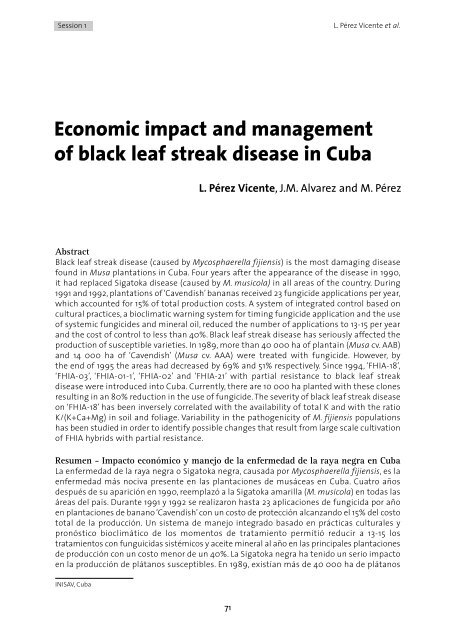Mycosphaerella leaf spot diseases of bananas - CBS
Mycosphaerella leaf spot diseases of bananas - CBS
Mycosphaerella leaf spot diseases of bananas - CBS
Create successful ePaper yourself
Turn your PDF publications into a flip-book with our unique Google optimized e-Paper software.
Session 1<br />
L. Pérez Vicente et al.<br />
Economic impact and management<br />
<strong>of</strong> black <strong>leaf</strong> streak disease in Cuba<br />
L. Pérez Vicente,J.M. Alvarez and M. Pérez<br />
Abstract<br />
Black <strong>leaf</strong> streak disease (caused by <strong>Mycosphaerella</strong> fijiensis) is the most damaging disease<br />
found in Musa plantations in Cuba. Four years after the appearance <strong>of</strong> the disease in 1990,<br />
it had replaced Sigatoka disease (caused by M. musicola) in all areas <strong>of</strong> the country. During<br />
1991 and 1992, plantations <strong>of</strong> ‘Cavendish’ <strong>bananas</strong> received 23 fungicide applications per year,<br />
which accounted for 15% <strong>of</strong> total production costs. A system <strong>of</strong> integrated control based on<br />
cultural practices, a bioclimatic warning system for timing fungicide application and the use<br />
<strong>of</strong> systemic fungicides and mineral oil, reduced the number <strong>of</strong> applications to 13-15 per year<br />
and the cost <strong>of</strong> control to less than 40%. Black <strong>leaf</strong> streak disease has seriously affected the<br />
production <strong>of</strong> susceptible varieties. In 1989, more than 40 000 ha <strong>of</strong> plantain (Musa cv. AAB)<br />
and 14 000 ha <strong>of</strong> ‘Cavendish’ (Musa cv. AAA) were treated with fungicide. However, by<br />
the end <strong>of</strong> 1995 the areas had decreased by 69% and 51% respectively. Since 1994, ‘FHIA-18’,<br />
‘FHIA-03’, ‘FHIA-01-1’, ‘FHIA-02’ and ‘FHIA-21’ with partial resistance to black <strong>leaf</strong> streak<br />
disease were introduced into Cuba. Currently, there are 10 000 ha planted with these clones<br />
resulting in an 80% reduction in the use <strong>of</strong> fungicide. The severity <strong>of</strong> black <strong>leaf</strong> streak disease<br />
on ‘FHIA-18’ has been inversely correlated with the availability <strong>of</strong> total K and with the ratio<br />
K/(K+Ca+Mg) in soil and foliage. Variability in the pathogenicity <strong>of</strong> M. fijiensis populations<br />
has been studied in order to identify possible changes that result from large scale cultivation<br />
<strong>of</strong> FHIA hybrids with partial resistance.<br />
Resumen - Impacto económico y manejo de la enfermedad de la raya negra en Cuba<br />
La enfermedad de la raya negra o Sigatoka negra, causada por <strong>Mycosphaerella</strong> fijiensis, es la<br />
enfermedad más nociva presente en las plantaciones de musáceas en Cuba. Cuatro años<br />
después de su aparición en 1990, reemplazó a la Sigatoka amarilla (M. musicola) en todas las<br />
áreas del país. Durante 1991 y 1992 se realizaron hasta 23 aplicaciones de fungicida por año<br />
en plantaciones de banano ‘Cavendish’ con un costo de protección alcanzando el 15% del costo<br />
total de la producción. Un sistema de manejo integrado basado en prácticas culturales y<br />
pronóstico bioclimático de los momentos de tratamiento permitió reducir a 13-15 los<br />
tratamientos con funguicidas sistémicos y aceite mineral al año en las principales plantaciones<br />
de producción con un costo menor de un 40%. La Sigatoka negra ha tenido un serio impacto<br />
en la producción de plátanos susceptibles. En 1989, existían más de 40 000 ha de plátanos<br />
INISAV, Cuba<br />
71

















